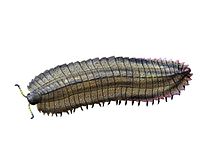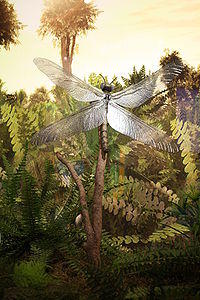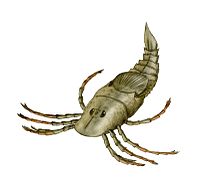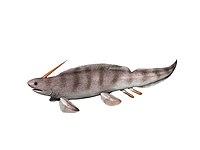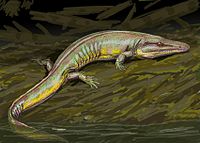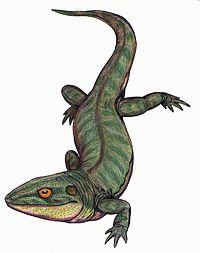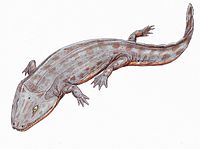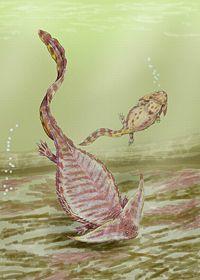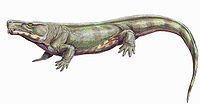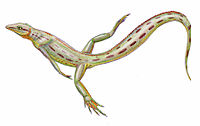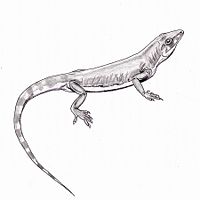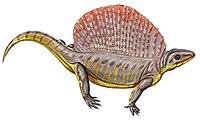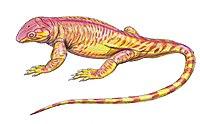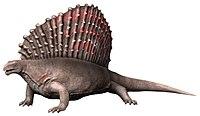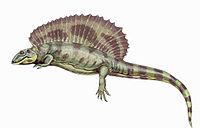| Gzhelian | |
|---|---|
| 303.7 ± 0.1 – 298.9 ± 0.15 Ma | |
| Chronology | |
Key events in the Carboniferous -360 — – -355 — – -350 — – -345 — – -340 — – -335 — – -330 — – -325 — – -320 — – -315 — – -310 — – -305 — – -300 — – Key events of the Carboniferous Period Axis scale: millions of years ago | |
| Etymology | |
| Name formality | Formal |
| Usage information | |
| Celestial body | Earth |
| Regional usage | Global (ICS) |
| Time scale(s) used | ICS Time Scale |
| Definition | |
| Chronological unit | Age |
| Stratigraphic unit | Stage |
| Time span formality | Formal |
| Type section | Gzhel horizon, Ghzel, Moscow Oblast, Russia |
| Lower boundary definition | Not formally defined |
| Lower boundary definition candidates | FAD of the Conodont Idiognathodus simulator[1] |
| Lower boundary GSSP candidate section(s) |
|
| Upper boundary definition | FAD of the Conodont Streptognathodus isolatus within the morphotype Streptognathodus wabaunsensis chronocline |
| Upper boundary GSSP | Aidaralash, Ural Mountains, Kazakhstan 50°14′45″N 57°53′29″E / 50.2458°N 57.8914°E |
| GSSP ratified | 1996[2] |
The Gzhelian is an age in the ICS geologic timescale or a stage in the stratigraphic column. It is the youngest stage of the Pennsylvanian, the youngest subsystem of the Carboniferous. The Gzhelian lasted from 303.7 to 298.9 Ma.[3] It follows the Kasimovian age/stage and is followed by the Asselian age/stage, the oldest subdivision of the Permian system.
The Gzhelian is more or less coeval with the Stephanian stage of the regional stratigraphy of Europe.
Name and definition
The Gzhelian is named after the Russian village of Gzhel (Russian: Гжель), nearby Ramenskoye, not far from Moscow. The name and type locality were defined by Sergei Nikitin (1850–1909) in 1890.
The base of the Gzhelian is at the first appearance of the Fusulinida genera Daixina, Jigulites and Rugosofusulina, or at the first appearance of the conodont Streptognathodus zethus. The top of the stage (the base of the Permian system) is at the first appearance of the conodont Streptognathodus isolatus within the Streptognathus "wabaunsensis" chronocline.[4] Six meters higher in the reference profile, the Fusulinida species Sphaeroschwagerina vulgaris aktjubensis appears.
At the moment (2008), a golden spike for the Gzhelian stage is yet lacking. A candidate is a section along the Ussolka river (a tributary of the Belaya river) at the edge of the hamlet of Krasnoussolsky, about 120 kilometres south-east of Ufa and 60 kilometres north-east of Sterlitamak (in Bashkortostan).[5]
Biozones
The Gzhelian stage is subdivided into five biozones, based on the conodont genus Streptognathodus:
- Streptognathodus wabaunsensis and Streptognathodus bellus Zone
- Streptognathodus simplex Zone
- Streptognathodus virgilicus Zone
- Streptognathodus vitali Zone
- Streptognathodus simulator Zone
Gzhelian life
Arthropods
| Arthropoda of the Gzhelian | ||||
|---|---|---|---|---|
| Taxa | Presence | Location | Description | Images |
| Flénu Formation, Belgium Middle Coal Formation, Pictou Group, Nova Scotia, Canada France Bochum Formation and Saarbrücker Schichten, Germany the Netherlands Middle and Lower Coal Measures, United Kingdom Arkansas, Carbondale Formation, Illinois, Allegheny Formation, Maryland, Pottsville Formation, Pennsylvania, United States | ||||
| Flénu Formation, Belgium France Saarbrücker Schichten, Germany Foel and Farrington Formations, United Kingdom and northeastern North America | A 2 m (79 in) long millipede | |||
| Pennsylvanian | France, England | A dragonfly with wingspans ranging from 65 cm (25.6 in) to over 70 cm (28 in) | ||
| Pallero member, Bajo de Véliz Formation, Argentina | A eurypterid | |||
Cartilaginous fishes
| Chondrichthyes of the Gzhelian | ||||
|---|---|---|---|---|
| Taxa | Presence | Location | Description | Images |
| Carboniferous | Czech Republic | A xenacanthidan elasmobranch | |
| Carboniferous to Cisuralian | Germany | A xenacanthidan elasmobranch | |
| Carboniferous to Cisuralian | Germany; Nebraska, United States | A xenacanthidan elasmobranch | ||
Amphibians
†Temnospondyls
| Temnospondyli of the Gzhelian | ||||
|---|---|---|---|---|
| Taxa | Presence | Location | Description | Images |
| Late Carboniferous | Jefferson County, Ohio | An early basal dissorophid, similar to Platyhystrix. | |
| Late Carboniferous-Early Permian | Texas, New Mexico; United States | An edopoid amphibian in the family Cochleosauridae. It was likely a terrestrial vermivore with relatively weak bite. | |
| Joggins and Parrsboro Formations, Nova Scotia, Canada | |||
| Spain | A genus of basal temnospondyl amphibian which lived in a marine environment. | ||
| New Mexico | A dvinosaurian temnospondyl within the family Trimerorhachidae | ||
| Thuringia, Germany | A genus of temnospondyl in the family Eryopidae. | ||
†Lepospondyls
| Lepospondyli of the Gzhelian | ||||
|---|---|---|---|---|
| Taxa | Presence | Location | Description | Images |
| Bond Formation, Danville, Illinois | |||
Reptiliomorphs
| Reptiliomorphs of the Gzhelian | ||||
|---|---|---|---|---|
| Taxa | Presence | Location | Description | Images |
| New Mexico | A diadectomorph | ||
| Colorado, New Mexico, United States | A diadectomorph | ||
Eureptiles
| Eureptilia of the Gzhelian | ||||
|---|---|---|---|---|
| Taxa | Presence | Location | Description | Images |
| Virgilian (late Kasimovian to early Gzhelian stage) | Greenwood County, Kansas, USA | The earliest and most basal known captorhinid reptile. | |
| Pennsylvanian | United States | An araeoscelidian diapsid, the earliest known reptile with two temporal fenestrae. | ||
| Stephanian | United States | A basal araeoscelidian diapsid, one of the earliest known reptiles with two temporal fenestrae and the first known reptile to return to the water,. | ||
Synapsids
| Synapsids of the Gzhelian | ||||
|---|---|---|---|---|
| Taxa | Presence | Location | Description | Images |
| Kasimovian-Gzhelian | Calhouns Shale Formation, Kansas, United States | A varanopid | |
| Pennsylvanian | Czech Republic | An edaphosaurid | |
| Remigiusberg Formation, Saar-Nahe Basin, Germany | A sphenacodontid | ||
| Kasimovian-Asselian | Ludwikowice Formation, Nowa Ruda, Poland | A caseasaur | |
| Pennsylvanian to Cisuralian | New Mexico, United States | An edaphosaurid | ||
| Kasimovian-Gzhelian | Kansas, United States | Eocasea is the oldest and most basal definite caseid. | |
| Pennsylvanian | Kansas, United States | An edaphosaurid | ||
| Pennsylvanian | Mattoon Formation, Illinois | A haptodontiform | |
| Kasimovian-Kungurian | Ada Formation, Oklahoma | An ophiacodont | ||
| Gzhelian-Artinskian | New Mexico; Utah-Arizona border region, both in USA; possibly England | The English specimen known as S?. brittanicus is now generally classified as Sphenacodontidae incertae sedis separate from the other Sphenacodon species so may need reassigning. | ||
References
- ^ a b "Global Boundary Stratotype Section and Point". International Commission of Stratigraphy. Retrieved 23 December 2020.
- ^ Davydov et al. 1998.
- ^ Gradstein, F.M.; Ogg, J.G. & Smith, A.G.; 2004: A Geologic Time Scale 2004, Cambridge University Press
- ^ Davydov, V.I.; Glenister, B.F.; Spinosa, C.; Ritter, S.M.; Chernykh, V.V.; Wardlaw, B.R. & Snyder, W.S.; 1998: Proposal of Aidaralash as Global Stratotype Section and Point (GSSP) for base of the Permian System, Episodes 21(1): pp 11-18, "Archived copy" (PDF). Archived from the original (PDF) on 2007-09-28. Retrieved 2007-09-28.
- ^ Chernykh, V.V.; Chuvashov, B.I.; Davydov, V.I.; Schmitz, M. & Snyder, W.S.; 2006: Usolka section (southern Urals, Russia): a potential candidate for GSSP to define the base of the Gzhelian Stage in the global chronostratigraphic scale Geologija 49(2): pp 205–217, "Archived copy" (PDF). Archived from the original (PDF) on 2007-12-14. Retrieved 2007-12-14.
External links
- Carboniferous timescale at the website of the Norwegian network of offshore records of geology and stratigraphy
- Gzhelian, GeoWhen Database
_6.jpg)
